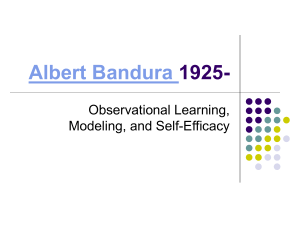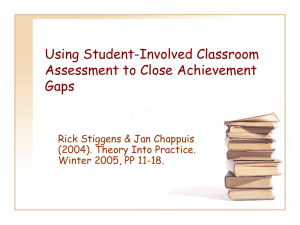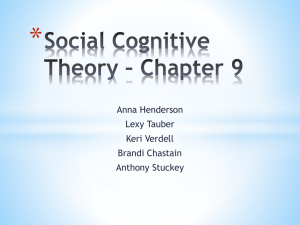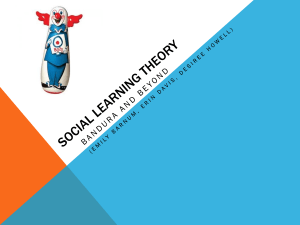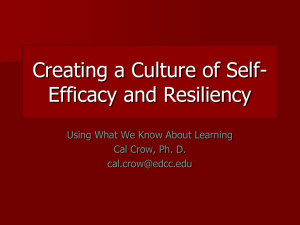Social Cognitive Career Theory of Career Choice Gail Hackett
advertisement
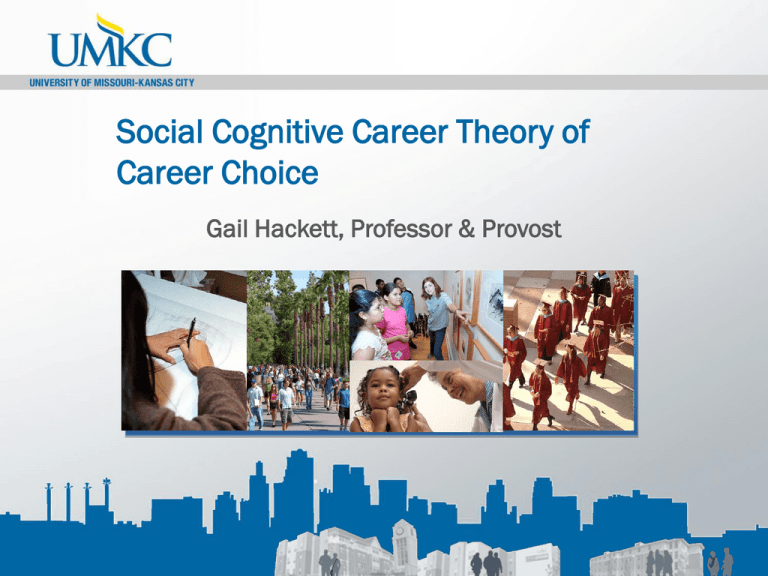
Social Cognitive Career Theory of Career Choice Gail Hackett, Professor & Provost Development of Bandura’s Work Social Learning Theory • Social learning & personality development (Bandura & Walters, 1963) • Principles of behavior modification (1969) Self Efficacy Theory (1977) • Level, strength & generality • Role in mediating choice, performance, persistence Social Cognitive Theory • Social foundations of thought & action: A social cognitive theory (1986) • Self efficacy: The exercise of control (1997) Our Early Work Applications of Bandura’s Self-efficacy Theory to women’s career development Hackett & Betz (1981) theoretical statement • Direct applications of self efficacy theory to explaining women’s under-representation in male-dominated occupations • Early areas of study: • Occupational self-efficacy and career interests • Math self-efficacy • Career decision making self-efficacy • Self-efficacy theory also had direct implications for intervention • Research quickly branched out into applications to career choice and development more generally Social Cognitive Career Theory: Origins • Based on Albert Bandura’s empirical/theoretical work over 4+ decades (1969, 1977, 1986, 1997) • Application of Bandura’s social cognitive theory to career behavior (Lent, Brown & Hackett) • Extended earlier work focused on career self-efficacy beliefs and their effect on career choice and achievement (Hackett & Betz) • Strong empirical evidence for core of model; increasing support for full model • Social cognitive theory accords a central role to cognitive, vicarious, selfregulatory and self-reflective processes in human adaptation and change (i.e., human agency) • Stands in contrast to conceptions of human functioning that overemphasize environmental or biological factors • Theory contains direct implications for intervention Reciprocal determinants of human functioning Social Cognitive Career Theory (Lent, Brown & Hackett, 1994, 2000, 2002) Contextual Influences Proximal to Choice Behavior Person Inputs Self-efficacy Expectations - Predispositions - Gender - Race/ethnicity - Disability/ Health status Learning Experiences Background Contextual Background Affordances Interests Outcome Expectations Goals Actions SCCT Model Person Inputs and background context Person Inputs - Predispositions - Gender - Race/ethnicity - Disability/ Health status Learning Experiences Background Contextual Affordances Distal Influences Person Inputs • • • Race/ethnicity, gender Physical appearance, health, disabilities Special abilities, e.g., intelligence, musical ability, artistic ability, muscular coordination Environmental conditions & events • • • • • • • • • • • Socioeconomic status Job & training opportunities Social policies & procedures for selecting trainees & workers Rate of return for various occupations (ROI) Labor laws, union rules Physical events (e.g., earthquakes, hurricanes, droughts, floods) Availability & demand for natural resources Technological developments (e.g., computers, web) Changes is social organizations Family training experiences & resources, neighborhood & community influences (e.g., family religion, values, expectations, women’s roles, availability of models, etc.) Education system (e.g., post-secondary opportunities affected tremendously by K-12 system) SCCT Model: Learning effects on efficacy and outcome expectations Self-efficacy Expectations Learning Experiences Outcome Expectations Key Components of Social Cognitive Theory Self-Efficacy Expectations: Beliefs in one’s capability to organize and execute the courses of action required to manage prospective situations (Bandura, 1986) Cognitive appraisals of one’s capacity to perform specific behaviors (future directed) Can you do this? How confident are you that you can do this? Efficacy beliefs influence initiation/choice of activities, effort expended, persistence in the face of obstacles, and ultimately success NOT self-esteem or other trait construct Outcome Expectations: Beliefs about the consequences of given actions What will happen if I do this? Consequences of successful performance Goals: Determination to engage in a particular activity or to produce a particular outcome What do I choose to do? By setting personal goals, people help to organize, guide, and sustain their own behavior Learning Influences: Sources of Self-Efficacy Information Prior Performance Accomplishment Vicarious Learning Self-Efficacy Social Persuasion Physiological and Affective Reactions Building Self-efficacy expectations Performance Accomplishments • Most powerful influence • Attributions of performance important for take-away message Vicarious Learning • Importance of model similarity along dimensions of importance to the observer • Observation of consequences of model’s behavior Social Persuasion • Best when source of persuasion is credible • Most commonly used but least powerful source of information • Couple with other informational sources Physiological States and Affective Reactions • Weak efficacy beliefs can produce anxiety/high levels of anxiety undermine performance • Anxiety reduction can enhance performance & self-efficacy Attributions of Performance Attributions of Success • Internal – Due to my own skills, abilities: likely to increase efficacy, performance • External – Easy test, course: likely to undermine or have no effect on efficacy, performance Attributions of Failure • Internal – Due to my lack of ability: undermining efficacy, performance • External – Due to the Instructor being a hard grader: No effect on efficacy, performance Observational Learning SCCT Model: Learning effects on efficacy and outcome expectations Self-efficacy Expectations Learning Experiences Outcome Expectations Key Components of Social Cognitive Theory Self-Efficacy: Beliefs in one’s capability to organize and execute the courses of action required to manage prospective situations •OR cognitive appraisals of one’s capacity to perform specific behaviors in the future • Can you do this? How confident are you that you can do this? • Efficacy beliefs determine initiation, choice of activities, effort expended, & persistence in the face of obstacles Outcome Expectations: Beliefs about the consequences of given actions • What will happen if I do this? • Consequences of successful performance Goals: Determination to engage in a particular activity or to produce a particular outcome • What do I choose to do? • By setting personal goals, people help to organize, guide, and sustain their own behavior Outcome X Efficacy Expectations SCCT Model: Contextual influences on interests, goals and actions Contextual Influences Proximal to Choice Behavior Self-efficacy Expectations Interests Outcome Expectations Goals Actions Key Components of Social Cognitive Theory Self-Efficacy: Beliefs in one’s capability to organize and execute the courses of action required to manage prospective situations •OR cognitive appraisals of one’s capacity to perform specific behaviors in the future • Can you do this? How confident are you that you can do this? • Efficacy beliefs determine initiation, choice of activities, effort expended, & persistence in the face of obstacles Outcome Expectations: Beliefs about the consequences of given actions • What will happen if I do this? • Consequences of successful performance Goals: Determination to engage in a particular activity or to produce a particular outcome • What do I choose to do? • By setting personal goals, people help to organize, guide, and sustain their own behavior Contextual Influences on Career and Academic Behavior • Objective and perceived aspects of the environment influence beliefs, intentions, & actions • Environmental barriers can erode efficacy and interests • Conversely, strong efficacy can enable an individual to surmount obstacles and persist in the face of barriers • Three Primary Paths of Contextual Influences – Distal (early) effects on acquisition of SE and OE – Moderators of interest-choice relations – Direct influences on choice Social Cognitive Career Theory Contextual Influences Proximal to Choice Behavior Person Inputs Self-efficacy Expectations - Predispositions - Gender - Race/ethnicity - Disability/ Health status Learning Experiences Background Contextual Background Affordances Interests Outcome Expectations Goals Actions Targets for Intervention Provide opportunities to build competencies Strengthen self-efficacy beliefs via the four sources of information Realistic self- appraisal of performance accomplishments • Engage in mastery experiences • Recognize strong performance • Develop accurate attributions of performance (success and failure) Provide strong and varied models • Diversity of academic, work models along varied dimensions of similarity • Coping vs. mastery modeling Couple verbal/social persuasion with other information sources Address undermining anxiety related to performance and choice Strengthen & expand vocational interests in high aptitude areas Link education to work/careers via career exploration (from written/visual information thru simulations, modeling, & job shadowing to practica & internships, research & work experience) Address unrealistic outcome expectations Minimize barriers & enhance facilitators Clarify academic & career goals Selected References Lent, R.W. (2013). Social cognitive career theory (pp. 115- 146). In S.D. Brown & R. W. Lent (Eds.), Career development & counseling: Putting theory and research to work (2nd Ed.). New York: Wiley. Hackett, G., & Lent, R.W. (2008). Social cognitive theory. In F. T. L. Leong (Editor-in-Chief), H.E.A. Tinsley (Senior Editor) & S.H. Lease (Associate Editor), Encyclopedia of counseling, Volume 2: Personal and emotional counseling. (pp. 767-769). Thousand Oaks, CA: Sage Publications. Betz, N.E., & Hackett, G. (2006). Career Self-efficacy Theory: Back to the Future. Journal of Career Assessment, 14, 3-11. Lent, R.W., Brown, S.D., & Hackett, G. (2002). Social cognitive career theory (pp. 255-311). In D. Brown, L. Brooks, and Associates, Career choice and development (4th Ed.). San Francisco, CA: Jossey-Bass. Lent, R.W., Brown, S.D., & Hackett, G. (2000). Contextual supports and barriers to career choice: A social cognitive analysis. Journal of Counseling Psychology, 47, 36-49. Hackett, G. (1995). Self-efficacy and career choice and development. In A. Bandura (Ed.), Self-efficacy in adaptation of youth to changing societies (232-258). Cambridge: Cambridge University Press. Lent, R. W., Brown, S.D. & Hackett, G. (1994). Toward a unified social cognitive theory of career/academic interest, choice, and performance. Journal of Vocational Behavior [Monograph], 45, 79-122. Hackett, G. & Betz, N.E. (1992). Self-efficacy perceptions and the career-related choices of college students. In D. H. Schunk & J. L. Meece (Eds.), Student perceptions in the classroom: Causes and consequences (pp. 229-246). Hillsdale, N.J.: Erlbaum. Lent, R. W., & Hackett, G. (1987). Career self-efficacy: Empirical status and future directions. Journal of Vocational Behavior, 30, 347-382. (Monograph.) Hackett, G. (1985). The role of mathematics self-efficacy in the choice of math-related majors of college women and men: A path analysis. Journal of Counseling Psychology, 32, 47-56. Hackett, G., & Betz, N. E. (1981). A self-efficacy approach to the career development of women. Journal of Vocational Behavior, 18, 326-339. Questions?
